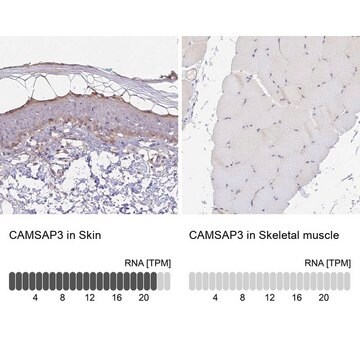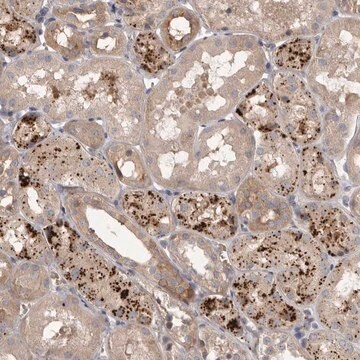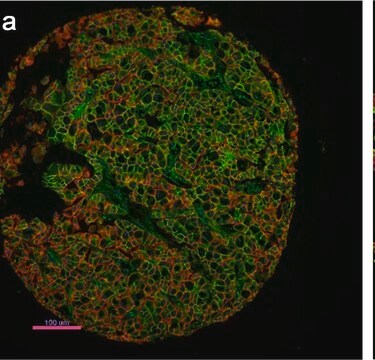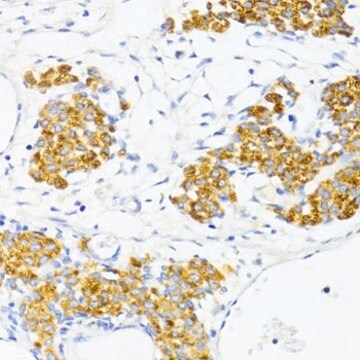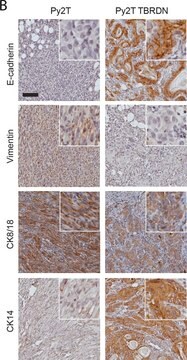SAB4200415
Anti-NEZHA antibody, Mouse monoclonal
clone NEZHA-1, purified from hybridoma cell culture
别名:
Anti-CAMSAP3, Anti-Calmodulin regulated spectrin-associated protein family member 3, Anti-KIAA, Monoclonal Anti-NEZHA antibody produced in mouse
登录查看公司和协议定价
所有图片(3)
About This Item
分類程式碼代碼:
12352203
NACRES:
NA.41
推荐产品
生物源
mouse
品質等級
共軛
unconjugated
抗體表格
purified from hybridoma cell culture
抗體產品種類
primary antibodies
無性繁殖
NEZHA-1, monoclonal
形狀
buffered aqueous solution
分子量
antigen ~150 kDa
物種活性
canine, human
濃度
~1.0 mg/mL
技術
immunoprecipitation (IP): suitable
indirect immunofluorescence: suitable
western blot: 2.5-5.0 μg/mL using whole extracts of human SW480 cells
同型
IgG1
UniProt登錄號
運輸包裝
dry ice
儲存溫度
−20°C
目標翻譯後修改
unmodified
基因資訊
human ... CAMSAP3(57662)
mouse ... Camsap3(69697)
一般說明
Monoclonal Anti-NEZHA (mouse IgG1 isotype) is derived from the hybridoma NEZHA-1 produced by the fusion of mouse myeloma cells and splenocytes from BALB/c mice immunized with a synthetic peptide corresponding to a sequence at the C-terminal region of human NEZHA, conjugated to KLH. Nezha (a deity in Chinese mythology) also known as KIAA1543 and calmodulin-regulated spectrin associated protein, is a 1276 amino acid protein that contains one calponin homology (CH) and two coiled coil (CC1 and 2) domains, as well as one DUF1781 (DUF) domain of unknown function. NEZHA is mapped to human chromosome 19p13.
NEZHA/ calmodulin regulated spectrin associated protein family member 3 (CAMSAP3) contains a conserved domain called cholecystokinin (CKK) domain at carboxy-terminal, as well as several coiled-coil regions and an calponin homology domain at amino-terminal.
免疫原
synthetic peptide corresponding to a sequence at the C-terminal region of human NEZHA, conjugated to KLH. The corresponding sequence is identical in mouse, rat, monkey and dog NEZHA.
應用
Monoclonal Anti-NEZHA antibody produced in mouse has been used in immunofluorescence staining.
Monoclonal Anti-NEZHA antibody produced in mouse has been used in:
- immunofluorescence
- immunoprecipitation
- immunofluorescence
- mass-spectrometry-based analysis of a streptavidin pull-down assay
- immunostaining
生化/生理作用
CAMSAP3 (calmodulin-regulated spectrin-associated protein 3)/ NEZHA modulates the minus-end dynamics of microtubules. It helps to maintain neuronal polarity. Absence of this gene results in the formation of supernumerary axon.
NEZHA/ calmodulin regulated spectrin associated protein family member 3 (CAMSAP3) facilitates translocation of Golgi vesicles in epithelial cells. In addition, it also helps in positioning the apical-to-basal polarity of microtubules in epithelial cells.
外觀
0.01M 磷酸缓冲盐溶液,pH 7.4,含 15mM 叠氮化钠。
免責聲明
Unless otherwise stated in our catalog or other company documentation accompanying the product(s), our products are intended for research use only and are not to be used for any other purpose, which includes but is not limited to, unauthorized commercial uses, in vitro diagnostic uses, ex vivo or in vivo therapeutic uses or any type of consumption or application to humans or animals.
未找到合适的产品?
试试我们的产品选型工具.
儲存類別代碼
10 - Combustible liquids
閃點(°F)
Not applicable
閃點(°C)
Not applicable
CAMSAP3-dependent microtubule dynamics regulates Golgi assembly in epithelial cells.
Wang J
Journal of Genetics and Genomics = Yi Chuan Xue Bao, 44, 39-49 (2017)
CAMSAP3 maintains neuronal polarity through regulation of microtubule stability
Pongrakhananon V, et al.
Proceedings of the National Academy of Sciences of the USA, 115(39), 9750-9755 (2018)
CAMSAP3 orients the apical-to-basal polarity of microtubule arrays in epithelial cells.
Toya M
Proceedings of the National Academy of Sciences of the USA, 113, 332-337 (2016)
Exome genotyping arrays to identify rare and low frequency variants associated with epithelial ovarian cancer risk
Permuth JB, et al.
Human Molecular Genetics, 25(16), 3600-3612 (2016)
Cadherin complexes recruit mRNAs and RISC to regulate epithelial cell signaling
Kourtidis A, et al.
The Journal of cell biology, 216(10), 3073-3085 (2017)
我们的科学家团队拥有各种研究领域经验,包括生命科学、材料科学、化学合成、色谱、分析及许多其他领域.
联系技术服务部门